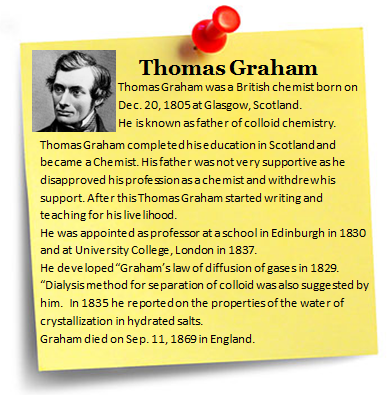Graham’s Law of Diffusion & Gas Eudiometry
Table of Content |
Graham’s Law of Diffusion / Effusion
-
 Diffusion in the ability of a gas to spread and occupy the whole available volume irrespective of other gases present in the container.
Diffusion in the ability of a gas to spread and occupy the whole available volume irrespective of other gases present in the container. -
Effusion is the process by which a gas escapes from one chamber of a vessel through a small opening or an orifice.

-
Thomas Graham in 1831 proposed the law of gaseous diffusion.
-
The law states that under similar conditions of temperature and pressure, the rates of diffusion of gases are inversely proportional to the square roots of their densities.
-
Mathematically

r ∝ 1 / √d
where r is the rate of diffusion and d is the density of the gas.
Now, if there are two gases A and B having r1 and r2 as their rates of diffusion and d1 and d2 their densities respectively. Then

Here M1 and M2 are the molecular masses of the gases having densities d1 and d2 respectively.
-
Graham’s law of diffusion also holds good for effusion.
Effect of Pressure on State of Diffusion
The rate of diffusion (r) of a gas at constant temperature is directly preoperational to its pressure
r ∝ P at constant temperature
r ∝ 1 / √d at constant temperature

Refer to the following video for Dalton’s Law of Partial pressure & Ghraham’s Law of Diffusion
Gas Eudiometry
The relationship amongst gases, when they react with one another, is governed by two laws, namely Gay-Lussac law and Avogadro’s law. Gaseous reactions for investigation purposes are studied in a closed graduated tube open at one end and the other closed end of which is provided with platinum terminals for the passage of electricity through the mixture of gases. Such a tube is known as Eudiometer tube and hence the name Eudiometry also used for Gas analysis.
-
During Gas analysis, the Eudiometer tube filled with mercury is inverted over a trough containing mercury.
-
A known volume of the gas or gaseous mixture to be studied is next introduced, which displaces an equivalent amount of mercury.
-
Next a known excess of oxygen is introduced and the electric spark is passed, whereby the combustible material gets oxidised.
-
The volumes of carbon dioxide, water vapour or other gaseous products of combustion are next determined by absorbing them in suitable reagents. For example, the volume of CO2 is determined by absorption in KOH solution and that of excess of oxygen in an alkaline solution of pyrogallol.
-
Water vapour produced during the reaction can be determined by noting contraction in volume caused due to cooling, as by cooling the steam formed during combustion forms liquid (water) which occupies a negligible volume as compared to the volumes of the gases considered.
-
The excess of oxygen left after the combustion is also determined by difference if other gases formed during combustion have already been determined.
From the data thus collected a number of useful conclusions regarding reactions amongst gases can be drawn.
-
Volume-volume relationship amongst Gases or simple Gaseous reactions.
-
Composition of Gaseous mixtures.
-
Molecular formulae of Gases.
-
Molecular formulae of Gaseous Hydrocarbons.
The various reagents used for absorbing different gases are
|
Gas |
Reagent Used |
|
O3 |
Turpentine oil |
|
O2 |
Alkaline pyrogallol |
|
NO |
FeSO4 solution |
|
CO2,SO2 |
Alkali solution (NaOH, KOH, Ca(OH)2, HOCH2CH2NH2, etc.) |
|
NH3 |
Acid solution or CuSO4 solution |
|
Cl2 |
Water |
|
Equation for combustion of hydrocarbons. |
General Assumptions: In all problems, it is assumed that the sparking occurs at room temperature. This implies that water formed would be in liquid state and that nitrogen gas is inert towards oxidation.
Example 2: |
|
Question: Solution: CxHy + (x + y/4) O2 → xCO2 + y/2 H2O 1 volume (x + y/4) volume x + y/4 = 6 (by equation) or 4x + y = 24 Again x = 4 since evolved CO2 is 4 times that of hydrocarbon 16 + y = 24 or y = 8 formula of hydrocarbon C4H8 |

Question 1: According to Ghraham’s Law of Diffusion
a. 
b. 
c. 
d. 
Question 2: During Gas analysis, the Eudiometer tube filled with
a. hydrogen
b. oxygen
c. carbon dioxide
d. mercury
Question 3: Graham’s law of diffusion also holds good for
a. viscosity
b. osmosis
c. effusion
d. expansion
Question 4: Which of the following reagents is used for absorbing oxygen gas?
a. Water
b.Turpentine oil
c. FeSO4 solution

|
Q.1 |
Q.2 |
Q.3 |
Q.4 |
|
a |
d |
c |
d |
Related Resources
-
Click here to go through Syllabus of IIT JEE,
-
Look here for Reference books of Chemistry
-
You can also refer Van der Waals Forces
To read more, Buy study materials of States of Matter comprising study notes, revision notes, video lectures, previous year solved questions etc. Also browse for more study materials on Chemistry here.
View courses by askIITians


Design classes One-on-One in your own way with Top IITians/Medical Professionals
Click Here Know More

Complete Self Study Package designed by Industry Leading Experts
Click Here Know More

Live 1-1 coding classes to unleash the Creator in your Child
Click Here Know More





